JimmyB
Now retired - trains and fishing
I think thyme waits for no man (or person).And a stitch in thyme save nine, what ever that means..
I think thyme waits for no man (or person).And a stitch in thyme save nine, what ever that means..

That must have been quite a spectacle.Wait, it just hit me. Burgess Merideth in the Twilight Zone episode where he comes out of a cellar, after surviving a nuclear attack. Since he is a book geek he is thrilled to be surrounded by all of the books that were once on the shelves of the library destroyed in the attack. As he bends over to pickup one last book, his glasses fall from his face and break on the floor.
View attachment 335343

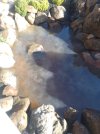
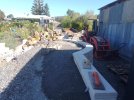
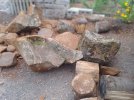
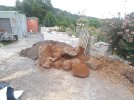
I had a leak from my pond too, I narrowed it down to the stream by switching off the main pump for a day and then the stream pump and the water level only fell when the stream was running. I checked for any damage to the stream pond liner and all was okay so I suspected capilliary action but was surprised when I found the true culprit. The ground covering plants had grown just over the edges of the stream and, as you say, caused a wick effect. The amount of water loss from such a trivial thing was a real eye opener. Anyway an attck with garden shears and secateurs and H2O stayed where it should be.I didn't glue the rubber of the stream to the pond liner, just overlapped it .I have seen on youtube that water can wick between rubber sheeting. If it's not that then its a hole behind the big rock at the back under the even bigger rock beside the stream.
I don't have the filter /waterfall running yet, so the leak is in the pond. It drops to the same level every time. I will know next week when I lift the smaller rocks in the corner where the stream liner will join the pond it just overlaps the pond liner , by about the amount (from memory) the pond is dropping too . The milk was clearly get drawn into that corner. So fingers crossed its that, cause that's a easy fix.I had a leak from my pond too, I narrowed it down to the stream by switching off the main pump for a day and then the stream pump and the water level only fell when the stream was running. I checked for any damage to the stream pond liner and all was okay so I suspected capilliary action but was surprised when I found the true culprit. The ground covering plants had grown just over the edges of the stream and, as you say, caused a wick effect. The amount of water loss from such a trivial thing was a real eye opener. Anyway an attck with garden shears and secateurs and H2O stayed where it should be.
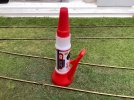
Thanks for the info on the glue , I put a thicker layer of liner under the rocks on top of the pond liner. Some of the rocks are pretty heavy thou . I have other things to fix this week, next week I should get some time to have a go at fixing it. Its not the end of the world if I can't , there is 30 cms of water in the pond to the leak level.Pond leaks can be a real pain, I keep getting adds on YouTube for a German glue that may help solve it if you can get to the leak. I have used it in a water based situation though I would use it with water level below hole just to be sure. As for other pond stuff, I always put rocks on a soft surface with some old liner on too to disguise it, expanded polystyrene or celtex house insulation has worked well for me.View attachment 336228
Indeed so, I have one bit that has had 3 lots of fill with cement (it is a small road area in front of buildings) over the 10 years since built, due for another fill after Xmas.Even going down to 50mm layers, I think you will find that your fill will settle a little?
I always warn people that if they build-up an area, it will settle, and need a top-up, at a later date.
It can be quite upsetting to build a bed, plant it, and it they settle several inches over the coming months.
PhilP
Its been down nearly a year , so think it has settled as much as it will . Compacting ( properly) does what time/gravity and rain does it forces particles into the small air gaps in the soil , so at 50mm layers I think it should not settle afterwards as all the air gaps would of been filled . At 100mm the equipment I have just wasn't heavy enough to fill all the air gaps. I did 5 layers and it has dropped 10mm at one end . I should of filled with only roadbase directly under the wall not half dirt half roadbase . Looking at the wall more closely I am now thinking the fill could of washed into the drain as well as sunk its down 15mm (which is not great but no real problem) at that end. I guess lessoned learned the hard way are remembered the most. I am about to get into fixing it so will know soon enough.Even going down to 50mm layers, I think you will find that your fill will settle a little?
I always warn people that if they build-up an area, it will settle, and need a top-up, at a later date.
It can be quite upsetting to build a bed, plant it, and it they settle several inches over the coming months.
PhilP
Yeah compactor plates aren't the best for deeper compaction layers, we mainly used whacker packers and could do 300mm layers in dirt/clay, but it needs to have some moisture in it but not too muchIts been down nearly a year , so think it has settled as much as it will . Compacting ( properly) does what time/gravity and rain does it forces particles into the small air gaps in the soil , so at 50mm layers I think it would not settle afterwards as all the air gaps would of been filled . At 100mm the equipment I have just wasn't heavy enough to fill all the air gaps. I did 5 layers and it has dropped 10mm at one end . I should of filled with only roadbase directly under the wall not half dirt half roadbase . Looking at the wall more closely I am now thinking the fill could of washed into the drain around the wall at one end as the other has not settled as much, only 2mm (which is not great but no real problem) at that end. I guess lessoned learned the hard way are remembered the most. I am about to get into fixing it so will know soon enough.
Yeah the plate compactor and running the tractor back and forward aren't the best tools for the job, that's why I thought I was safe at 100mm layers. Trying to compact wet roadbase is hilarious the way it wobbles all around and lifts beside the compactor.Yeah compactor plates aren't the best for deeper compaction layers, we mainly used whacker packers and could do 300mm layers in dirt/clay, but it needs to have some moisture in it but not too much
as it will just wobble like jelly and not compact, even road base will do that.
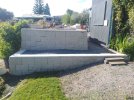
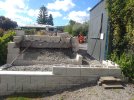
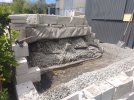
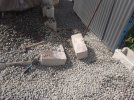

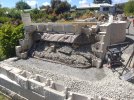
You probably are right Alan , I should of done that at the start. That ship has sailed I am afraid. I can't get the digger into that corner now so it would have to be done by hand, and that is beyond me to dig down that much, and I would have to cut back the ground above I think too. So rightly or wrongly that's not going to happen. The wall is not going to collapse its only holding back a small amount of ground, with good drainage behind it. Different story if it was cut into a hillside like that, it would blow out with a big rain for sure.Stewie, I think you need to take the end wall down to the same level as the side wall, at least 3 blocks along, that way that corner is bearing on the same
sub base. I commend you on your efforts in the heat, I know I can't handle it as I used to.
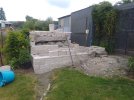
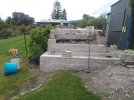
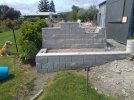
Thanks Paul , hopefully at the start of next year I will be finished with all this heavy landscaping stuff and I can lay some track and run some trainsStewie, this has been a very interesting and informative thread. I look forward to your next posts and the transformation into a working garden railway.
